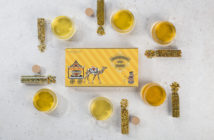Delicious Downward Dog:
- Begin by taking deep breaths, becoming aware of your body and if there is any tension.
- Slowly sip your warm cup of tea, enjoying each breath. Embrace the quiet. Take a few moments here.
Movement:
- Come down onto your hands and knees in a crawling position. Your knees should be below your hips and your arms in front of shoulders.
- Take a good look at your hands. Widen your fingers. Make sure your palms and each of your fingers touch the ground. Feel the pressure of the ground beneath your hands.
- What are your toes doing? Downward dog is partially about becoming aware of all parts of your body. Take the time to touch the tips of your toes (slightly curled) to the ground and slowly lengthen your legs (at first leave your heels off the ground and keep your knees bent). Look back at your feet. Keep them hip width apart.
- Become aware of your back. Picture a large rope wrapped around your waist and feel your hips and tailbone slightly lifting up. Bring your sit bones up into the air (it’s a very powerful rope) and gently rotate your thighs inward to help your body maintain this posture.
- With an exhalation, push your top thighs back and bring your heels closer to the ground. If they can’t touch, use yoga bricks to assist and place your heels on the bricks.
- What are your arms doing? Lengthen your arms. Recognize the strength in your arms. Firm your arms and hands to the ground and lift your shoulders up and back.
- What is your head doing? If it’s hanging like a rag doll, bring your head between your two arms. In downward dog you are using your entire body.
- Absorb the feeling of this posture and how downward dog is meant to feel. Stay in the posture as long as feels right. To reach the full benefits of the posture, try to stay in it for 1 to 3 minutes.
- Return to a seated position. Keep breathing and slowly sip the rest of your cup of tea.
Learn how to pair over 18 yoga poses with teas and tisanes in our free Wellness & Tea 101 E-Book. Click the image below to download it now.
note that this article was previously published in Oct 2014





